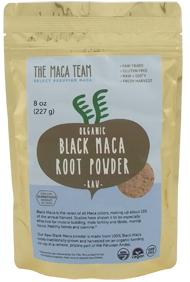The 3 Types of Maca Root That You Need in Your Life
Maca is one of the nature’s best superfoods. This root vegetable was initially cultivated in the higher altitudes of South America and has been used as a dietary staple and medicine for thousands of years. Maca root has traditionally been used for boosting libido, fertility, and stamina. It is also currently being investigated for its importance in dealing with issues such as osteoporosis and prostate related health issues.
Individuals suffering from metabolic syndrome, which are a series of conditions surrounding high blood pressure, heart conditions, and high cholesterol, may also benefit from maca ingestion. Some people have even begun to explore maca for its mood-altering phytochemicals, as there is evidence to suggest it was used as a treatment for depression.
The Best Selection of Certified Organic Maca Products Anywhere
Maca is now more widely available outside of South America. It is sold as a vegetable in specialty grocery stores worldwide and is even more widely available in its supplemental form in health food stores. There are 13 types of known maca root varieties, however, they are all referred to scientifically as Lepidium meyenii. Most of the research so far has been surrounding three specific types, each evidenced to have their own specific characteristics and medicinal benefits.
3 Common Varieties of Maca Root
- Yellow (can be more white)
- Red (can also be more purple or pink)
- Black (can also be a shade of grey)
The different colors of the maca root only go skin deep, with the interior remaining the same light yellow color. No matter what the variety, however, the maca root looks very similar to a turnip. What this means is that the colors of the actual powders vary only slightly and will all be a light cream coloring. The current scientific research has demonstrated that these colors have somewhat different properties, so let’s take a closer look.
1. Yellow Maca
 Main medicinal applications of yellow maca include increasing energy, vitality, fertility, and balancing hormones.
Main medicinal applications of yellow maca include increasing energy, vitality, fertility, and balancing hormones.
Cream colored maca is the most widely grown and are favored in Peru for their enhanced sweetness and size. Maca yellow can be consumed in its vegetable form or the powder can be used as salad dressings or consumed with the fruit smoothie. Yellow maca comes with a tangy taste.
Yellow maca is often referred to as a natural Viagra because of its ability to boost libido. It is also known for its ability to enhance fertility and enhance the mood. Research has also discovered that yellow maca is very helpful in dealing with symptoms associated with menopause such as hot flashes and in balancing hormonal levels.
2. Black Maca
 Main medicinal applications of black maca include increasing sperm production, boosting memory, improving concentration, and increasing bone density.
Main medicinal applications of black maca include increasing sperm production, boosting memory, improving concentration, and increasing bone density.
Black maca is considered the strongest in energy, with exceptional effects on stamina. Like yellow maca root, it is both sweet and a little bitter in taste, similar to roasted soybeans.
Just like the other varieties, black maca is believed to boost fertility and enhance sex drive. Black maca root has been evidenced to have the most neuroprotective characteristics out of all the different colors. It also seems to have the most spermatogenesis effects. In a 2009 study out of Peru, black maca proved to be the best for increasing sperm production, motility, and volume as well as for increasing libido. In 2011, two different studies, one from China and one from Peru, found that black maca root helped laboratory mice improve their memory and concentration skills.
Black maca is also believed to strengthen the immune system against common infections such as flu and cold.
3. Red Maca
 Main medicinal applications of red maca include reducing prostate size, potential as an antitumoral, and increasing bone density.
Main medicinal applications of red maca include reducing prostate size, potential as an antitumoral, and increasing bone density.
Red maca is the rarest of all varieties of maca. It is sometimes a shade of pink or purple maca but is most generally categorized as red. Red maca is becoming very popular as it contains the highest amount of amino acids which are the building blocks of protein in the body. When compared to either black or yellow, red maca tends to have a maltier taste.
This red version has been found to be very helpful in boosting overall mood, helping people manage stress and reduce the symptoms of depression. Due to its coloring, red maca root provides a large range and supply of antioxidants.
One study done on red maca reported that only the red root seemed to reduce ventral prostate size in rats. The study also went on to report that through phytochemical analysis of 7 functional nutrient groups, red maca demonstrated the highest levels for each of the groups in comparison to other colors. These phytochemical compounds support the body with antioxidants and antitumoral characteristics.
How To Consume Maca Root
The most common way to consume maca root is in a powdered or capsule form. Always start incorporating powerful supplements into your diet slowly, especially with maca root. The strength of its benefits varies widely, and it is important to take your time when determining the best dosage.
Try starting with only ¼ tsp. a day taken in the morning. Never increase daily dosage to anything over 3 tsps. a day. In the higher range of doses, it is also important to break it up into smaller doses throughout the day. Because maca can create a biological dependency, where your body can naturally begin to get used to the effects, always cycle your use of maca root on a month on and a month off rotation. This will ensure your body remains receptive and responsive to the phytonutrients.
A Word of Caution
Maca is an adaptogen. An adaptogenic substance is one that demonstrates a nonspecific enhancement of the body’s ability to resist a stressor. While there are many herbs that tend to have this quality, it is not recommended that you take two or more adaptogenic herbs together.
Some examples of adaptogenic herbs include ashwagandha, ginseng, rosemary, moringa and licorice root. It’s also recommended to avoid combining with other fertility drugs. Prior to adding maca root into your diet, always consult with a physician to avoid any unforeseen complications.
References
https://www.themacateam.com/#oid=1042_1
https://examine.com/supplements/maca/
https://www.themacateam.com/raw-yellow-maca#oid=1042_1


